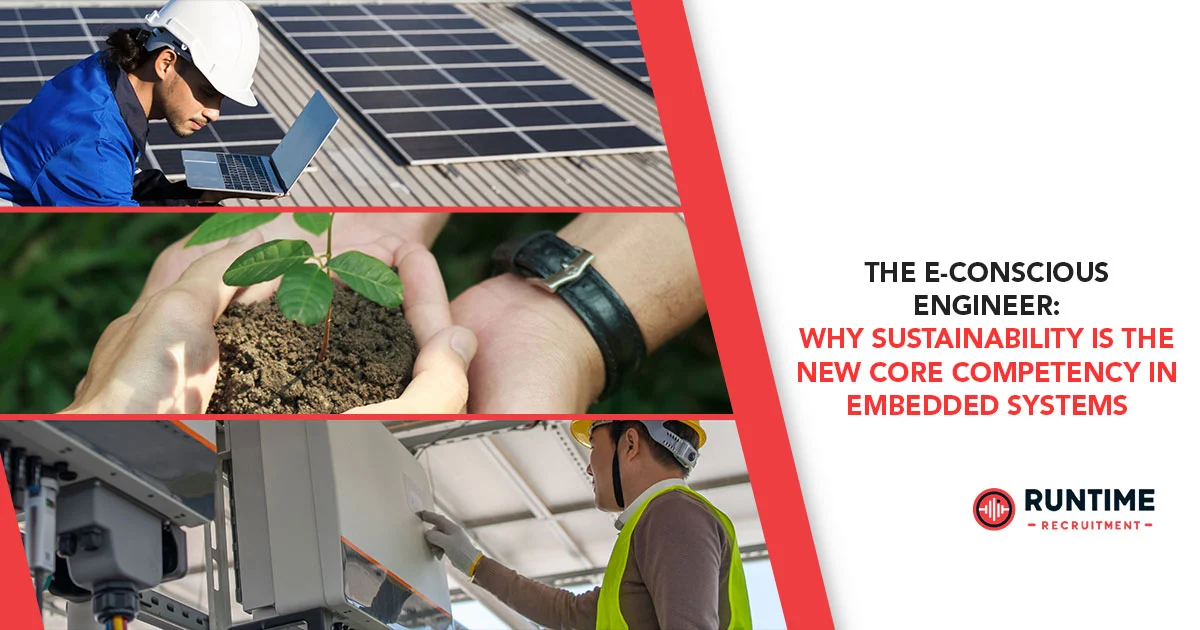The embedded systems world is at an inflection point. For decades, the primary metrics for success have been performance, cost, and time-to-market. These remain crucial, but a new, powerful, and non-negotiable metric has entered the equation: sustainability. This isn’t a peripheral concern or a marketing buzzword; it is a fundamental design constraint that is rapidly reshaping product development and, critically, the demand for engineering talent.
We are entering an era where the environmental footprint of connected devices—from the IoT sensor array on a factory floor to the microcontroller in a smart thermostat—is under intense scrutiny. The industry is realizing that the collective power consumption and the mountains of electronic waste (e-waste) generated by billions of devices are unsustainable. This reality has triggered a profound shift in hiring priorities, creating a massive, urgent demand for a new breed of professional: the Energy-Efficient and E-Waste-Conscious Embedded Engineer.
This article is an in-depth exploration for embedded engineers and the companies that hire them, detailing this paradigm shift, the specific technical skills now in demand, the challenges of the circular economy in embedded design, and how to successfully navigate this new talent landscape.
The Unsustainable Status Quo: Why We Must Change
To understand the scope of the shift, we must first quantify the problem embedded systems contribute to:
The Energy Consumption Crisis
The International Energy Agency (IEA) estimates that the energy consumption of connected devices is a significant and growing portion of global electricity demand. While individual microcontrollers consume minuscule power, the sheer scale of the Internet of Things (IoT)—projected to hit over 30 billion devices by 2025—makes the aggregate impact staggering. A device drawing a few milliwatts 24/7, multiplied by billions, results in Gigawatt-hours of wasted energy annually, primarily due to:
- Inefficient Sleep/Wake Cycles: Devices spending too long in high-power states during idle periods.
- Sub-Optimal Code: Firmware that requires more clock cycles than necessary for a given task.
- Poor Component Selection: Choosing high-leakage current components or inefficient power regulators (e.g., linear regulators over DC-DC converters).
- Network Overhead: Continuous, power-hungry wireless communication when burst-mode or edge processing would suffice.
The E-Waste Epidemic
The Global E-waste Monitor reported that over 53 million metric tons of e-waste were generated in a single year, with embedded devices contributing heavily. Unlike large electronics (like TVs), embedded systems often have short life cycles and are designed for single-use or challenging disassembly. Miniaturization, coupled with a lack of standardization, makes recycling incredibly difficult and uneconomical. The issue is compounded by:
- Planned Obsolescence: Software/firmware updates cease, or crucial components are soldered in a way that prevents repair.
- Material Choice: The use of exotic, hard-to-recover materials and non-standard plastics/adhesives.
- Lack of Modular Design: Integrated circuits are often permanently encapsulated, making material separation impossible at the end-of-life (EoL).
This dual crisis—energy waste and material waste—has created a clear business imperative. Regulatory bodies (like the EU with its Circular Economy Action Plan), corporate customers, and increasingly, end-users, are demanding verifiable, sustainable products. Sustainability is no longer a feature; it’s a foundational requirement for market access.
The New Engineering Mandate: Skills in High Demand
The job market is already reflecting this change. Hiring managers are moving beyond basic C/C++ proficiency and RTOS experience. They are specifically screening for engineers who embed sustainability into the design philosophy.
1. Mastery of Ultra-Low Power Firmware & Software
This is the most immediate and critical skill area. The energy-conscious engineer must be a power-profiling virtuoso and an assembly-level code optimizer.
- Dynamic Power Management (DPM): Deep expertise in implementing techniques like Dynamic Voltage and Frequency Scaling (DVFS), which adjusts the processor’s clock and voltage on the fly to match workload demand.
- Finite State Machines (FSMs) for Power: Designing firmware architectures that strictly control power states, maximizing time spent in deep sleep modes (e.g., STOP, STANDBY) and minimizing the transition time in and out of them. This requires a deep understanding of peripheral clock gating and wake-up sources (e.g., low-power timers, pin-change interrupts).
- Algorithm and Data Structure Efficiency: Knowledge of how memory access, data type choices, and algorithm complexity directly translate to energy use. For example, favoring small, stack-based data structures over dynamic allocation, and selecting energy-efficient algorithms (e.g., an optimized hash function over an un-optimized linear search).
- Peripheral Optimization: Writing bare-metal or driver-level code that uses peripherals (ADC, DAC, SPI, I2C, UART, etc.) only when necessary, clock-gating them immediately afterward, and leveraging DMA to avoid unnecessary CPU wake-ups for data transfer.
2. Design for Circularity and EoL (End-of-Life) Planning
The e-waste-conscious engineer champions the “design out waste” philosophy of the Circular Economy. This is an emerging discipline that bridges electronics design with materials science and logistics.
- Design for Disassembly (DfD) and Repair (DfR): Specifying modular PCBs, using standard fasteners (screws) over permanent adhesives, selecting socketed or easily removable components, and ensuring open-access to repair documentation. This extends product life and simplifies material recovery.
- Material-Conscious Component Selection: Moving beyond cost/performance and vetting components based on their environmental impact. This includes avoiding difficult-to-recycle materials, minimizing rare earth element (REE) usage, and favoring halogen-free laminates for PCBs.
- Long-Term Software Support: Designing robust, modular firmware and Over-The-Air (OTA) update mechanisms that can extend the functional life of the product long after the hardware is considered obsolete. This means thinking in terms of decades, not just a product’s initial warranty period.
- Predictive Maintenance/Diagnostics: Implementing sophisticated diagnostic tools and monitoring firmware to predict component failure. This allows for scheduled, targeted repair/refurbishment instead of blanket replacement.
3. Integrated Power and Thermal Management
Sustainability is inextricably linked to thermal management, as wasted energy is released as heat, which often shortens component lifespans and decreases system reliability.
- Power Rail Optimization: Expertise in switching regulator design (buck, boost, LDO) and selection, understanding the trade-offs between ripple, efficiency, and transient response to maximize battery life or minimize grid load.
- Thermal-Aware Design: Implementing temperature-sensing routines in the firmware that trigger safe, low-power modes before thermal runaway occurs, which is crucial for safety, reliability, and lifespan.
- Energy Harvesting Integration: For remote or IoT devices, designing systems to operate on ultra-low power and efficiently utilize energy harvesting sources (solar, thermal, kinetic) to eliminate battery use or extend recharge cycles dramatically.
The Hard Truth: Challenges and Trade-offs
Embracing sustainability in embedded design is not without its hurdles. Engineers must become masters of compromise, navigating competing constraints:
| Constraint | The Sustainability Conflict | Engineering Solution |
| Cost | Sustainable materials (e.g., halogen-free PCBs) and modular designs often have a higher initial Bill of Materials (BOM) cost. | Justify higher BOM with lower EoL costs, higher customer retention, and compliance with impending regulations. The total cost of ownership (TCO) is the new metric. |
| Size/Density | DfR demands more space (socketed components, standard screws) than permanently glued, miniaturized assemblies. | Employ advanced 3D packaging (e.g., SiP/SoC) to integrate functions, thereby creating physical space for the mechanical disassembly features. |
| Time-to-Market | Thorough power profiling and EoL logistics analysis adds significant time to the design validation phase. | Integrate power profiling from Day One of the design cycle. Use simulation/virtual prototyping tools to test EoL scenarios concurrently with functional testing. |
| IP Protection | DfR often requires open documentation or user-accessible modules, which can expose intellectual property (IP). | Abstract proprietary functions into tamper-proof firmware modules while keeping hardware interfaces and repair procedures open. Focus on protecting the algorithm (software) over the form-factor (hardware). |
The challenge is clear: sustainability must be designed in from the first block diagram, not bolted on at the end. This requires an integrated approach, demanding collaboration between hardware, firmware, mechanical, and supply chain teams—a multi-disciplinary fluency that is the new gold standard for embedded engineers.
The Business Advantage of Sustainable Engineering
For companies, the investment in sustainable engineering talent yields clear, tangible returns that go far beyond environmental goodwill:
- Risk Mitigation: Staying ahead of stringent governmental regulations (like the EU’s Digital Product Passport and WEEE directive) prevents costly redesigns, fines, and market access denial.
- Product Longevity and Brand Loyalty: Products known for durability, repairability, and continuous software support command a premium and build fierce brand loyalty—a significant competitive edge in the crowded IoT market.
- Operational Savings: Ultra-low power designs translate directly to lower warranty costs (fewer battery replacements), reduced servicing (fewer thermal-related failures), and lower operational energy expenses for deployed devices.
- Talent Attraction: The best engineers—especially those early in their careers—are increasingly mission-driven. Companies that embed sustainability into their core values attract and retain elite talent who want their work to have a positive global impact.
The search for an engineer who can optimize a device to run for ten years on a single coin cell battery, and whose final hardware assembly is 95% recoverable, is the search for the industry’s future leader. This engineer is a strategic asset, not just a technical resource.
Call to Action: Connect with RunTime Recruitment
The shift toward energy-efficient and e-waste-conscious engineering is not a slow trend—it is a market-driven, regulatory-accelerated revolution. The demand for engineers with specialized skills in DPM, DfR, and circular design principles is surging, and the talent war is intensifying.
For Engineers ready to leverage your power-optimization and e-waste mitigation skills for a rewarding career: Your expertise is now mission-critical. You are the vanguard of the sustainable technology movement.
For Hiring Managers and CTOs seeking to future-proof your product line: You need a recruitment partner who speaks the language of low-power design, knows the difference between a simple low-power mode and advanced DVFS implementation, and has an existing network of sustainability-focused hardware and firmware experts.
Don’t wait for your competitors to corner the sustainable talent market.
Connect with RunTime Recruitment today. We specialize in connecting top-tier embedded, firmware, and electronics engineers with forward-thinking companies. Let us help you find the E-Conscious Engineer who will drive your company’s next-generation, sustainable product success.









